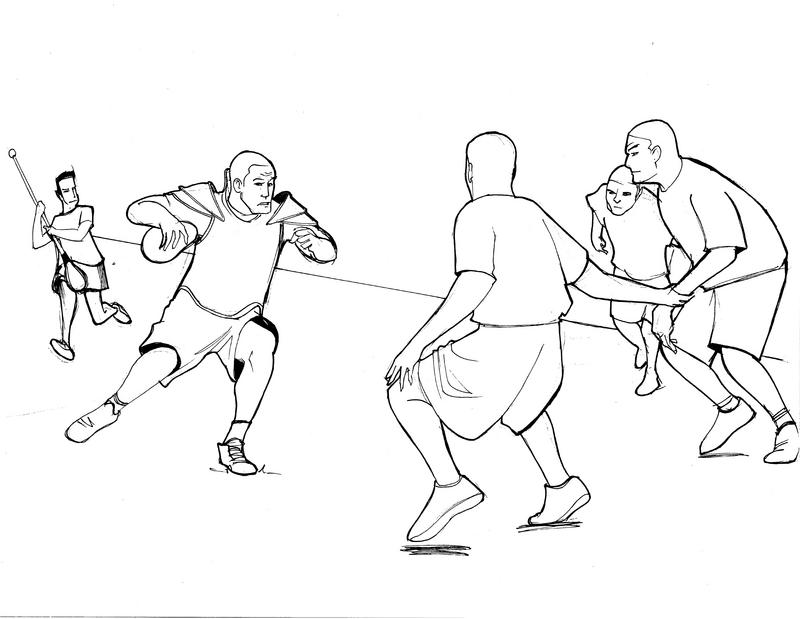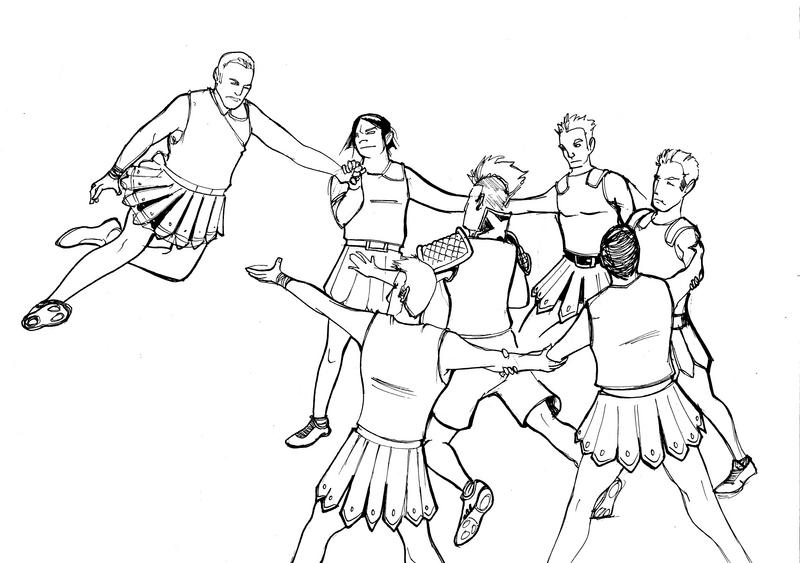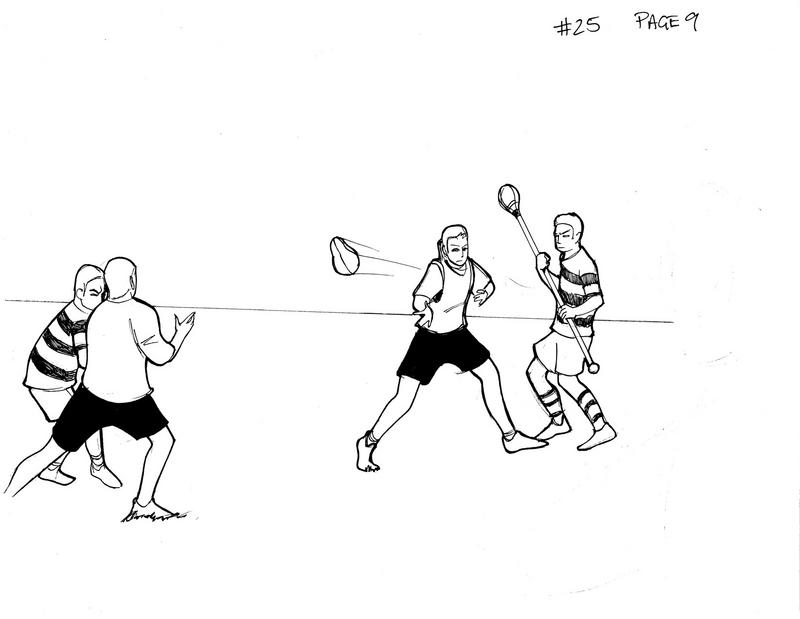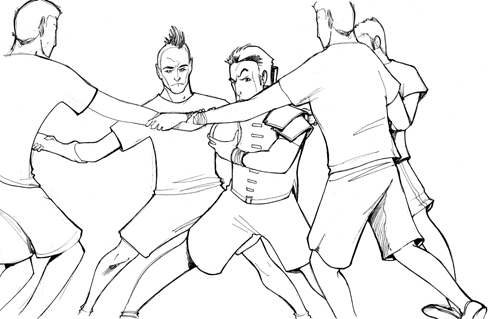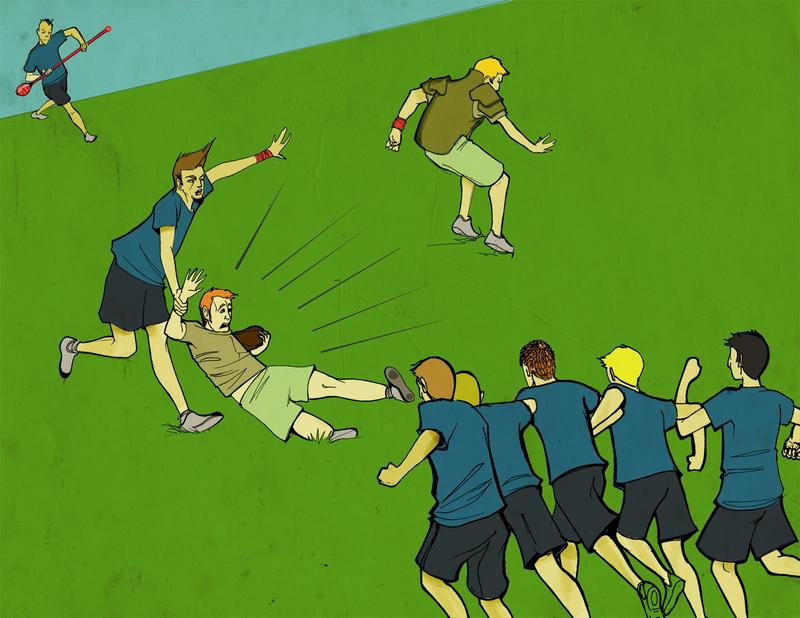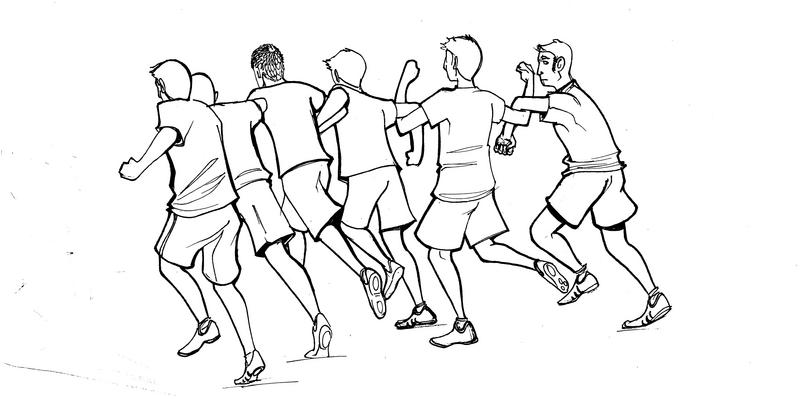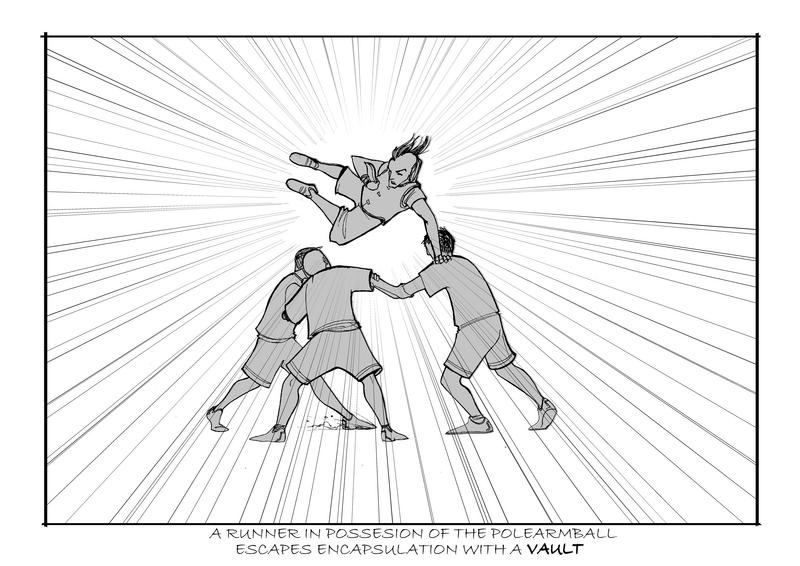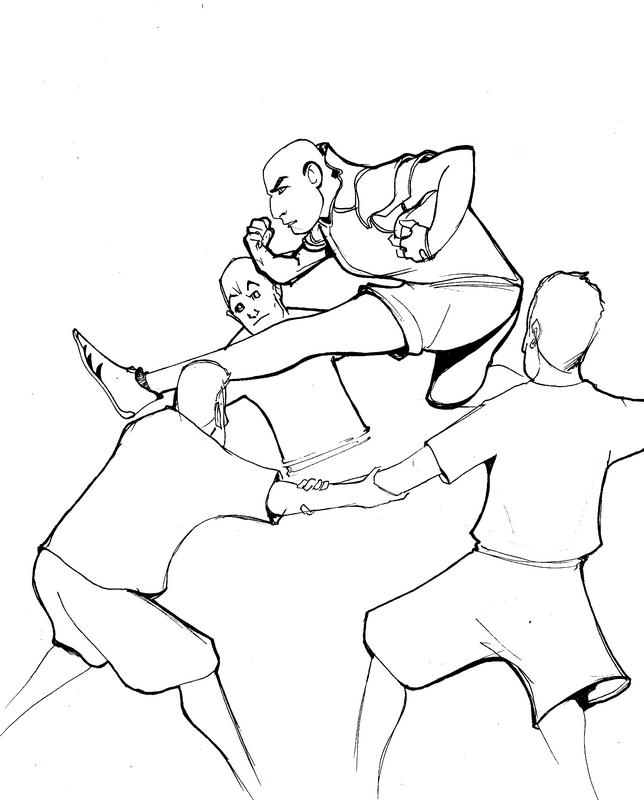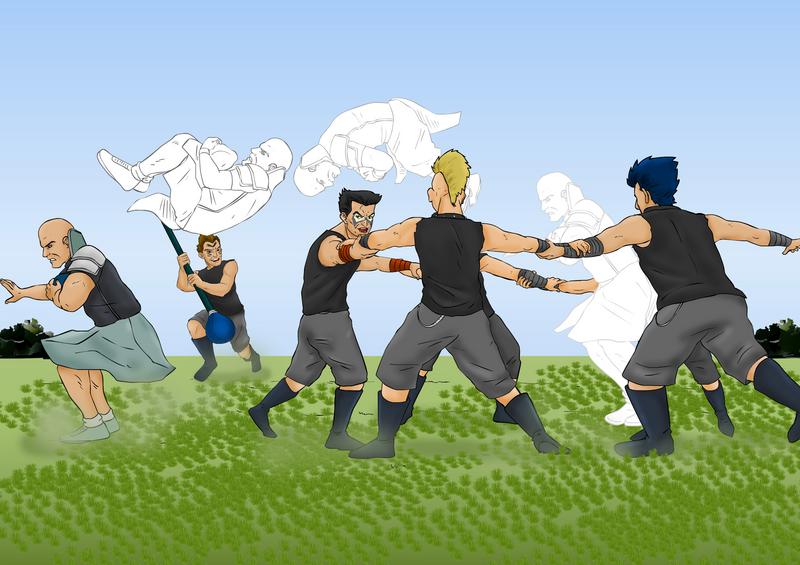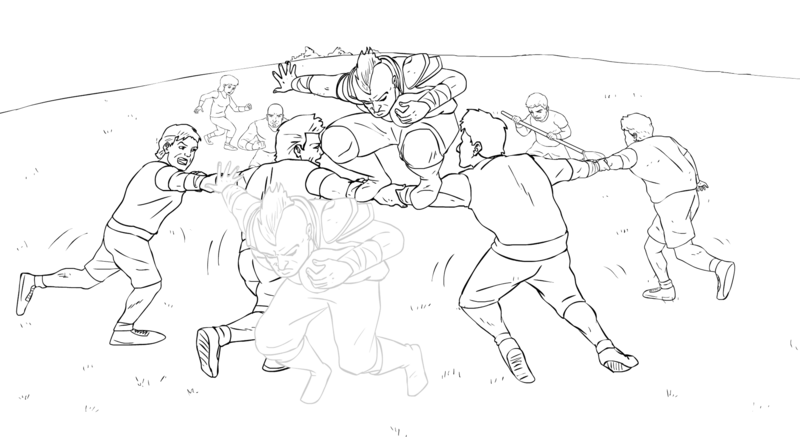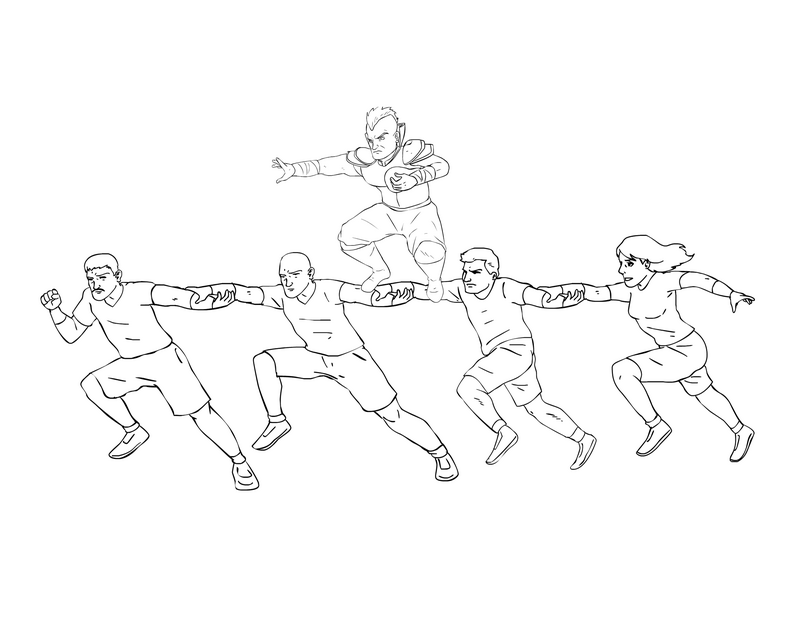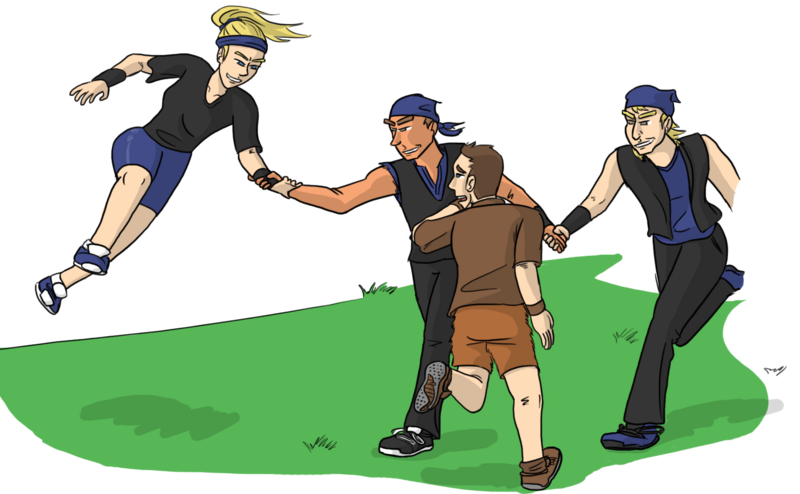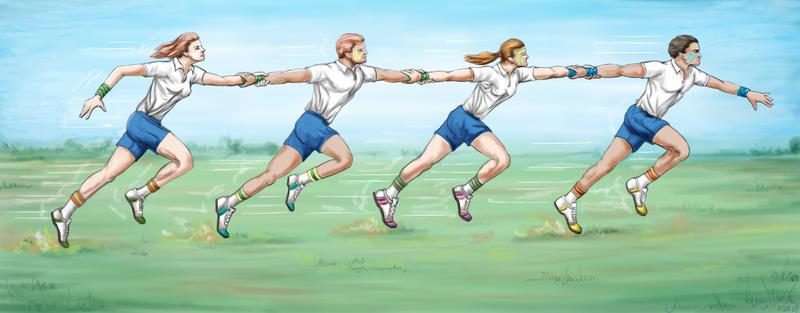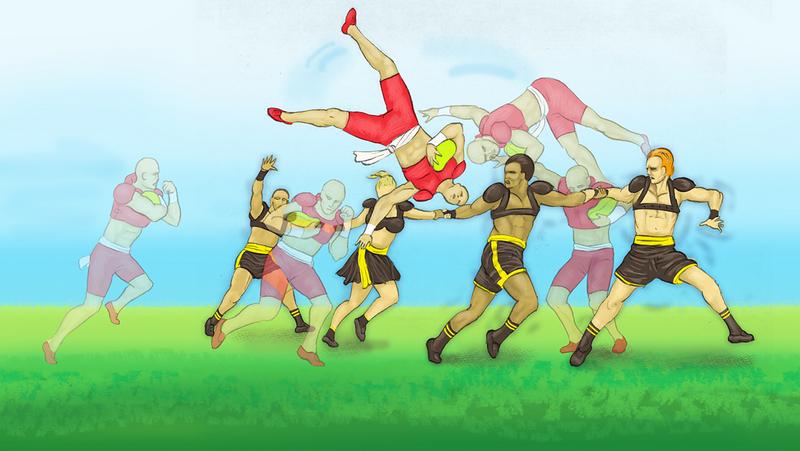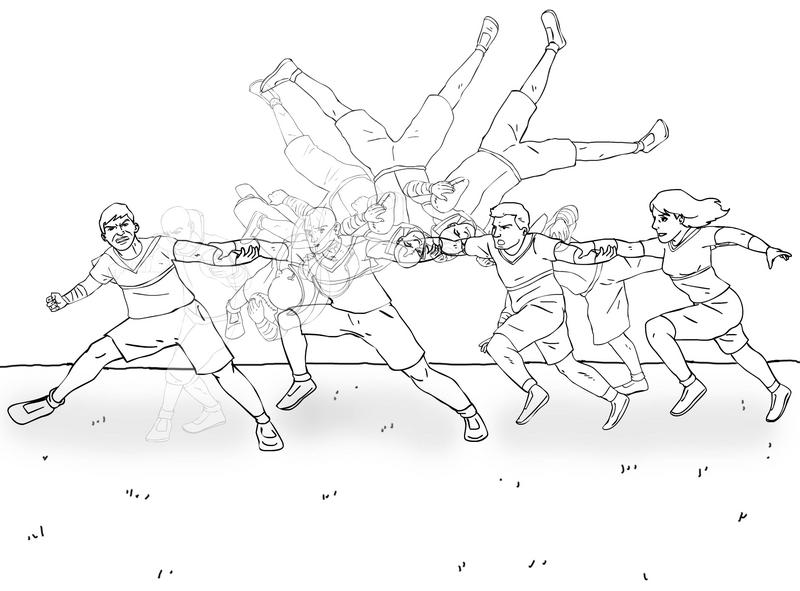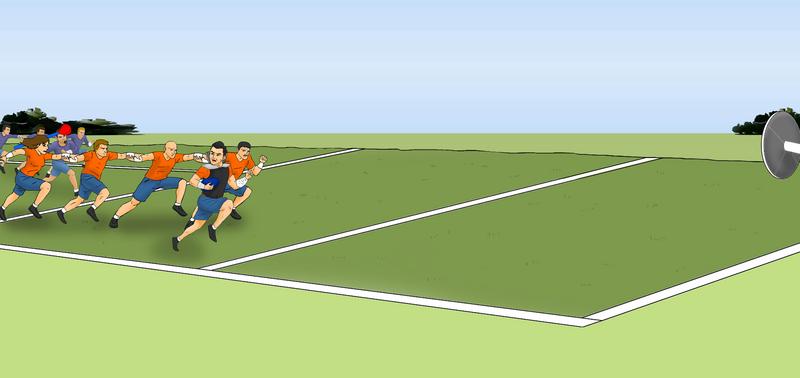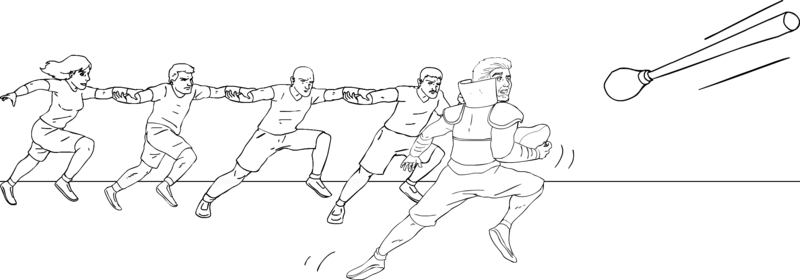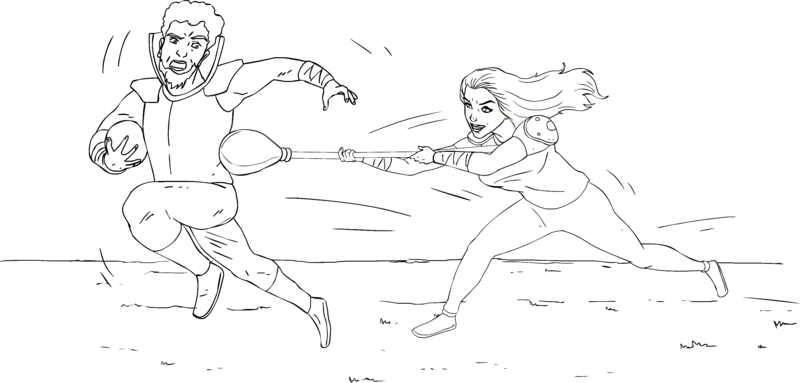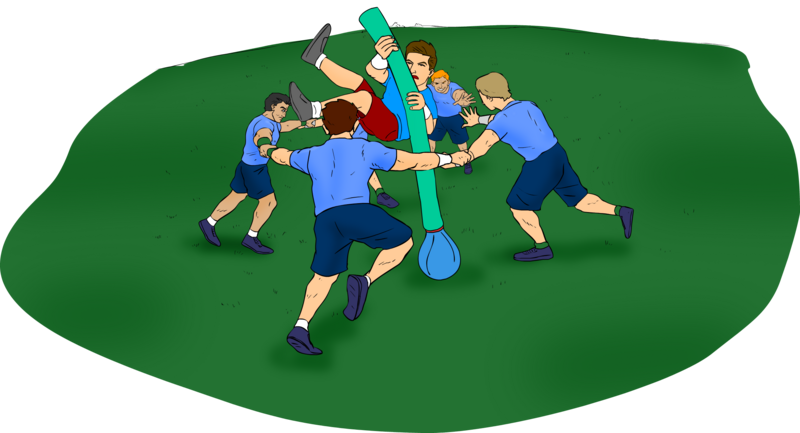The Rule Book
Page Four (4)
The only time that the Runner may touch the polearm without penalty is after he/she crosses a Delivery Line and attempts to block an airborne polearm from hitting the target. If the polearm touches the Runner during a round before the Runner makes a delivery then sides switch and the Runner's team loses possession of the ball. It is considered a Kill for the opposing team.
During the course of a round the Runner may choose to pass the ball to his/her teammates. The Runner remains a target whether he/she has possession of the ball or not. The purpose of relinquishing posession of the ball is so that the ball may be passed ten times among the Runner's teammates before the ball is returned to the Runner. If successful then the Delivery score will be doubled when the Runner crosses a Delivery Line with the ball. This simulates the other members of the Runner's tribe filling the sack with goods and supplies. More goods and supplies means the sack in the role playing aspect of the game now has more value.
In this scene the Runner has encountered an obstacle. The Runner is encumbered in a way which allows the Polearmist to have a shot at the Runner to either spear him/her with an airborne polearm by throwing it, or to run up to the Runner and joust him/her. There is also a possibility of someone running up to the Runner and grabbing his/her free arm in order to fling the Runner to the ground.
In this scene an encapsulation is ensuing. Encapsulations are dynamic fast paced maneuvers. The last player in this scene to run in and join the human chain is actually airborne as he/she comes in to close the circle around the Runner. Whipping the last player is a maneuver called a Fling. The last player to join a chain may be Flung around as a measure to produce a lightening fast encapsulation.
In this scene the Runner is shown passing the ball to a teammate in order to attempt Doubling. The Runner's teammates must successfully pass the ball ten (10) times before they return the ball to the Runner. A Delivery made by the Runner after Doubling is worth twice the original value. In effect, the sack has been filled with more goods by the Runner's teammates thus increasing the value of the Delivery.
In this scene the Runner has been successfully encapsulated. The opposing team scores a Kill and sides switch. The Runner's team loses possession of the ball.
In this scene a player who is not the Runner has possession of the ball due to a Doubling attempt and has been successfully flung to the ground. Sides switch and the Runner's team loses possession of the ball. The opposing team scores a Kill but it is not worth as much as when the Runner is flung.
In this scene a line of players have formed an obstacle on the playing field. Human chains will be dynamic well coordinated lightening fast units. The players in this scene are beginners. More adept players will join hands to wrists and be a tightly held well synchronized lightening fast unit. Forearms will be wrapped with cord, cloth, tape, or other grip holding material that will prevent moisture on the arms from making the skin slippery.
Doubling and more clarifications...
The Runner may choose to pass the ball to his/her teammates. The purpose is to attempt a process of passing the ball ten (10) times between teammates. The ball may not be passed back to the Runner until ten passes have been completed. If the ball is passed back to the Runner before ten passes are completed then the game continues without Doubling and the chance for Doubling is forfeited. During the Doubling process the Runner remains a target and if the Runner is speared, jousted, encapsulated, or flung, then the sides switch and the opposing team scores a full value Kill. In other words, the Runner does not have to have possession of the ball in order for sides to switch if the Runner gets speared, jousted, encapsulated, or flung.
Sides may also switch if the Runner fumbles or drops the ball. The ball cannot touch the ground. No Kill is awarded.
If the Runner touches the ground with any other part of his/her body other than his/her feet then the sides switch. If not due to flinging then no Kill is awarded. If the Runner is flung (as defined by the rules) to the ground then sides switch and a Kill is awarded.
If the Runner passes the ball to his teammates and one of the teammates gets jousted while in possession of the ball then sides switch. The Runner's teammates may not be speared. They may only be jousted or flung. The polearm may only be thrown at the Runner.
If a teammate in possession of the ball becomes encapsulated then sides switch. A Kill is awarded but it is not worth as much as the Runner.
If a teammate who has possession of the ball is flung to the ground as defined by the rules, then the sides switch. A Kill is awarded but it is not worth as much as the Runner. If a teammate fumbles or drops the ball then sides switch. No Kill is awarded.
Again, a Runner’s teammate may not be speared. Only the Runner who wears protective equipment may have the polearm thrown at him/her.
The Runner must make a Delivery to his/her village in order to score points. He/she is carrying goods intended for his/her tribe which is represented by the polearmball. The target is a physical representation of his/her village. Once a Runner delivers his/her goods to his/her village by crossing a Delivery Line and scores a Delivery he/she must then defend his/her village from attack by pursuers. Within five seconds after the Runner crosses a Delivery Line the opposing team must have the polearm airborne if they wish to attempt to damage the village by hitting the target. Five seconds after the Runner crosses the Delivery Line a buzzer will sound and the polearm must be airborne by then. If the polearm is not airborne when the buzzer sounds then the throw won't count after that. The Runner will dash over to the target and attempt to block or deflect the incoming polearm from striking and damaging the village (target).
The team which is in possession of the polearm during a round will attempt to encumber the Runner in such a way so as to create a shot for the Polearmist (person in possession of the polearm) who has the polearm in his/her hands at that moment. The polearm may be passed freely to any teammate.
A warrior/player in possession of the polearm may receive assistance from his/her teammates who may encumber the Runner and help create a line of fire so that the Polearmist may choose to throw the polearm at the Runner or joust the Runner whether the runner has possession of the ball or not.
In times of old a tribe member may approach his village from various directions. A tribal warrior could come in from the North, South, East, or West. This is why in Polearmball a Runner may run to either side of the playing field to score a Delivery. He/she may approach his/her village from any direction. Either Delivery Line is fair game at any time during a playing round or scrimmage. The Runner may choose to run in either direction and change his/her mind at will before he/she decides which Delivery Line he/she wants to cross at either end of the field.
You Are On Page 4
Parkour - Gymnastics - Acrobatics
Parkour, Gymnastics, Or Acrobatic Skills May Be Used By A Runner To Overcome An Obstacle Being Formed By His Opponents
It follows that when a Runner is confronted with the threat of an ensuing encapsulation or blockade then he/she will be looking to escape or evade the threat. A human chain or blockade formed by a line of arm-locked opponents may also threaten to encumber the Runner's path even if the blockade is not in the process of an encapsulation.
If a Runner or any player finds that they are confronted with an obstacle such as a chain of opponents locked together in a line then that player has the option to use acrobatic, gymnastics, or parkour maneuvers to soar over the line. Care must be taken not to hit the heads of the players below when ascending or overcoming the line. At the discretion of the referee a foul may be called if the acrobat hits someone's head as he/she goes over the blockade. Should a foul be called it will be processed as an option for each and every player in the line.
Parkour, Gymnastics, Or Acrobatic Skills May Be Used By A Runner To Overcome An Obstacle Being Formed By His Opponents
Parkour, Gymnastics, Or Acrobatic Skills May Be Used By A Runner To Overcome An Obstacle Being Formed By His Opponents. In this scene the Runner squats on and jumps off.
In this scene the Runner is surfing the line. The Runner has jumped up on his feet to the arms and shoulders of either his opponents or own teammates and is balancing while the chain is sprinting. The Chain may or may not be the Runner's own teammates.
Be careful in the event that you get too close to your enemy's human chain. They may decide to attempt an encapsulation of you. In this scene a stray teammate has sprinted to her team's chain and as she latches herself at the end she is then flung around with lightening speed while airborne in order to quickly surprise and encapsulate the opponent.
In this scene the athletes have been practicing for many years and are able to sprint in unison. As much as the leader may pull on the chain to increase the chain's speed so may the other members of the chain push forward as they run. The arms are straight and locked together like iron rods. This is an elite team perfectly synchronized and able to sprint and change direction with great skill.
A human chain attempts to block the path of the Runner. The Runner decides to overcome the blockade using a free-running maneuver called an aerial cartwheel...
As opposed to an aerial cartwheel here is a Shoulder Cartwheel over a human chain... note the Runner makes contact with his shoulder against the arms of the players in the chain.
Game Concepts In A Nutshell
During a round of play, the Runner’s teammates will work in unison to enable and assist the Runner to score a delivery. The opposing team will also work in unison among themselves to encumber and prevent the Runner from scoring a Delivery. The Runner’s enemies will also attempt to cause sides to switch so that they may gain possession of the ball. Sides switch when the Runner is hit by the polearm (speared or jousted), or the Runner is encapsulated (surrounded by interlocked enemy warriors), or when the Runner is flung (swung to the ground by one arm).
In the role playing aspect of the game whether a war party is stalking their enemy or a hunting party is stalking their prey, it is understood that the warriors will encounter obstacles in the wild such as bolders, trees, logs, rocks, streams, rivers, brush, etc. If you are the prey then these obstacles may either serve to facilitate escape, give shelter, or encumber one's path. If you are the pursuer then these obstacles may also slow you down or serve to shelter you or give you an advantage for an ambush.
During a round of play, the Runner’s teammates will work in unison to enable and assist the Runner to score a delivery.
It is a main object of the game for both teams to continually form obstacles on the field. The Runner's team will be forming obstacles in order to shelter the runner from being speared or jousted and also to facilitate a clear path for the Runner to run toward a Delivery Line. The opposing team will be forming obstacles in order to impede the Runner in a way which will allow the Polearmist (player in possession of the polearm (Javel), to have a shot at the Runner to either spear him/her by throwing the polearm or running up to him/her and jab the Runner with the polearm (joust him/her), or to gain proximity to the Runner so that an opponent may grab the Runner's free arm and fling the Runner to the ground. Also, the Runner may be encapsulated by a ring of players who have formed an obstacle by joining their arms, or wrists, or hands and thus being interlocked they manage to surround the Runner in an interlocked circle. If the Runner is speared, jousted, flung, or encapsulated, then the round ends and the opposing team scores a kill.
The opposing team will be forming obstacles in order to impede the Runner in a way which will allow the Polearmist (player in possession of the polearm (Javel), to have a shot at the Runner to either spear him/her by throwing the polearm or running up to him/her and jab the Runner with the polearm (joust him/her), or to gain proximity to the Runner so that an opponent may grab the Runner's free arm and fling the Runner to the ground.
Polearmist jousting the Runner!
Victim Pole Vaults out of ensuing Encapsulation!
